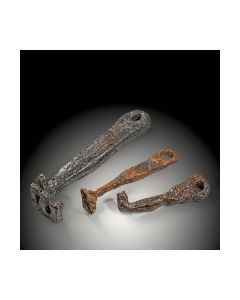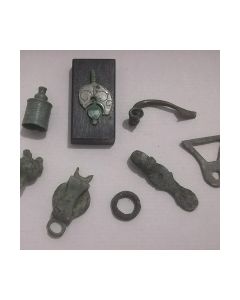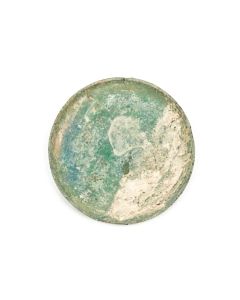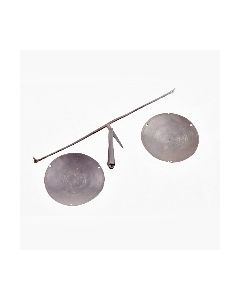Tools - Classical antiquity - Sold antiquities
Archive of sold antiquities
All artefacts sold in our gallery are fully documented in our online archive and database. Being a specialist ancient art dealer, preserving also the more recent history of each and every piece sold in our shop is at our heart. That is particularly useful for artefacts that changed owners in the meantime. Information that may have been lost in the process can be easily restored from our archives. Please do not hesitate to contact us if you need further information about ancient items that have been sold in our gallery. We can help you with reconstructing the history of ownership for those items. All information about our customers will be kept confidential, of course.-
 Roman glass inkwell
Roman glass inkwellLow vessel of cylindrical shape. The stylus was dipped into the ancient inkwell and wiped off at the edge. Beautiful, rich green glass.
Price: on request Two Roman lock bolts from Novaesium
Two Roman lock bolts from NovaesiumEach was part of a key lock, e.g. for a door or chest. Finds from the Roman city of Novaesium, today's Neuss in Germany.
Price: on request Roman seal box
Roman seal boxPiriform body with engraved bird on the lid. A piece from the Roman Imperial period, found near Dover. Published in a standard work by Richard Hattatt.
Price: on request Roman seal box with phallus
Roman seal box with phallusCircular body with protective phallus in high relief on the lid. A piece from the Roman Imperial period, found in North East England. Published in a standard work by Richard Hattatt.
Price: on request Roman lead weight from Novaesium
Roman lead weight from NovaesiumTrapezoidal weight from the Roman city of Novaesium, today's Neuss in Germany.
Price: on request Three Roman iron keys from Novaesium
Three Roman iron keys from NovaesiumIron keys of typical shape. Finds from the Roman city of Novaesium, today's Neuss in Germany.
Price: on request Roman key ring
Roman key ringFinger ring made of bronze with a key. From the Roman Imperial period, around the 2nd century. A find from the Roman city of Novaesium, today's Neuss in Germany.
Price: on request Roman clay ball
Roman clay ballMassive clay sphere, ammunition or a pistill. A find from the Roman city of Novaesium, today's Neuss in Germany.
Price: on request Roman glass rod
Roman glass rodThe object had a function as a distaff, a tool for spinning. Particularly noteworthy is the beautiful spiral decoration and the complete preservation of the fragile material. From the Roman Imperial period.
Price: on request Ancient ladle with donkey head terminal
Ancient ladle with donkey head terminalElegant long bronze ladle, from the Greek or Etruscan culture. 5th to 4th century BC.
Price: on request Six Roman iron nails
Six Roman iron nailsDifferent shapes of nails. Finds from the Roman city of Novaesium, today's Neuss in Germany.
Price: on request Roman-Egyptian spindle whorl from mosaic glass
Roman-Egyptian spindle whorl from mosaic glassCone-shaped spindle whorl from the time of Roman rule over Egypt. The beautifully made mosaic glass weight is certainly a showpiece of every collection.
Price: on request Ancient ladle with bird head terminal
Ancient ladle with bird head terminalElegant long bronze ladle, from the Greek or Etruscan culture. 5th to 4th century BC.
Price: on request Roman glass fragments from the Rhineland
Roman glass fragments from the RhinelandFragments of glass vessels and rods, as well as two faience beads. Finds from the Roman city of Novaesium, today's Neuss in Germany.
Price: on request Three Roman lead weights from the Rhineland
Three Roman lead weights from the RhinelandDifferent types of weights made of lead. Finds from the Roman city of Novaesium, today's Neuss in Germany.
Price: on request Eight Roman bronze artifacts
Eight Roman bronze artifactsVarious artifacts in different states of preservation. Finds from the Roman city of Novaesium, today's Neuss in Germany.
Price: on request Four Roman iron artefacts
Four Roman iron artefactsArrow heads, chisel and blade made of Iron. Finds from the Roman city of Novaesium, today's Neuss in Germany.
Price: on request Eight Roman bronze artefacts
Eight Roman bronze artefactsVarious artefacts in different states of preservation. Finds from the Roman city of Novaesium, today's Neuss in Germany.
Price: on request Roman bronze lock bar shaped as herm
Roman bronze lock bar shaped as hermMassive piece with great patina. From a German private collection, acquired in the early 1980s.
Price: on request Roman bronze lock bar
Roman bronze lock barMassive piece shaped as a herm, with great patina. From a German private collection, acquired in the early 1980s.
Price: on request Roman mirror from Baalbek
Roman mirror from BaalbekThe bronze disc is the base plate of a bronze mirror, that was once attached to a handle and coated with a reflective metal layer. Typical for upper class Roman households during Imperial times.
Price: on request Roman mirror from Baalbek
Roman mirror from BaalbekThe bronze disc is the base plate of a bronze mirror, that was once attached to a handle and coated with a reflective metal layer. Typical for upper class Roman households during Imperial times.
Price: on request Roman strigilis with workshop mark
Roman strigilis with workshop markExcellently preserved, massive bronze, stable. Workshop mark "N" on the reverse.
Price: on request
 Roman bronze strainer from "Museum fuer Morgenlandfahrer"
Roman bronze strainer from "Museum fuer Morgenlandfahrer"Large piece in very good condition with nice patina. On display in "Ex Oriente Lux" exhibition, published in the corresponding catalogue.
Price: on request Roman scale balance with pans
Roman scale balance with pansWell preserved small bronze scale. Including two dished pans decorated with incised concentric rings.
Price: on request Roman specillum
Roman specillumThe so-called specillum is a surgical probe. It was standard issue for roman doctors. Similar probes are still in use today. 1st to 4th cent. AD.
Price: on request Roman surgical probe made of bronze
Roman surgical probe made of bronzeThe so-called specillum was standard issue for roman doctors. Similar probes are still in use today. Very fine craftsmanship of an ancient surgical instrument.
Price: on request Roman surgical probe made of silver
Roman surgical probe made of silverThe so-called specillum was standard issue for roman doctors. Similar probes are still in use today. Ancient surgical instruments made of silver are extremely rare.
Price: on request Antikes Werkzeug, kosmetisch (G)
Antikes Werkzeug, kosmetisch (G)Römisches Werkzeug aus Bronze, für medizinische oder kosmetische Zwecke. 1. bis 3. Jhd. n.Chr. 5,3cm lang.
Price: on request Antiker Pin, kosmetisch oder medizinisch (F)
Antiker Pin, kosmetisch oder medizinisch (F)Römisches Werkzeug aus Bronze, für medizinische oder kosmetische Zwecke. 1. bis 3. Jhd. n.Chr. 5,8cm lang.
Price: on request Antiker Löffel, kosmetisch oder medizinisch (D)
Antiker Löffel, kosmetisch oder medizinisch (D)Römisches Werkzeug aus Bronze, für medizinische oder kosmetische Zwecke. 1. bis 3. Jhd. n.Chr. 5,5cm lang.
Price: on request Antiker Pin, kosmetisch oder medizinisch (H)
Antiker Pin, kosmetisch oder medizinisch (H)Römisches Werkzeug aus Bronze, für medizinische oder kosmetische Zwecke. 1. bis 3. Jhd. n.Chr. 7,2cm lang.
Price: on request Antiker Pin, kosmetisch oder medizinisch (L)
Antiker Pin, kosmetisch oder medizinisch (L)Römisches Werkzeug aus Bronze, für medizinische oder kosmetische Zwecke. 1. bis 3. Jhd. n.Chr. 10,1cm lang.
Price: on request Antiker Löffel, kosmetisch oder medizinisch (J)
Antiker Löffel, kosmetisch oder medizinisch (J)Römisches Werkzeug aus Bronze, für medizinische oder kosmetische Zwecke. 1. bis 3. Jhd. n.Chr. 8,2cm lang.
Price: on request Antiker Pin, kosmetisch oder medizinisch (I)
Antiker Pin, kosmetisch oder medizinisch (I)Römisches Werkzeug aus Bronze, für medizinische oder kosmetische Zwecke. 1. bis 3. Jhd. n.Chr. 8,0cm lang.
Price: on request

